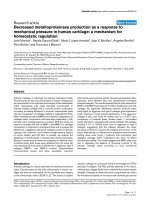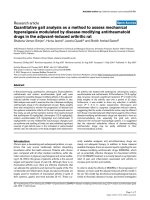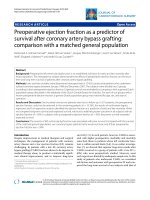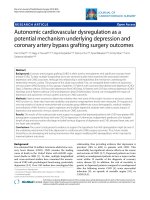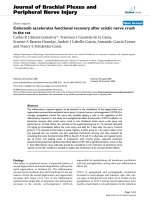Báo cáo y học: "Myocardial Doppler velocities as a marker of prognosis in the ICU" pot
Bạn đang xem bản rút gọn của tài liệu. Xem và tải ngay bản đầy đủ của tài liệu tại đây (38.47 KB, 2 trang )
Page 1 of 2
(page number not for citation purposes)
Available online />Abstract
Relatively simple measures of echocardiography and Doppler, as
left ventricular end-systolic area and volume, should be taken in
consideration when performing a Doppler echocardiographic
examination, as they could have both clinical and prognostic value.
Echocardiography made an enormous technological evolu-
tion from M mode imaging in the sixties, to two-dimensional,
colour, pulsed and continuous wave Doppler echocardio-
graphy to come to some rather sophisticated items such as
myocardial Doppler imaging, colour Doppler analysis of flow
velocities and speckle tracking. The prognostic potential of
these new techniques has not yet been elucidated, in
particular in critically ill patients. In this issue of Critical Care,
Sturgess et al. retrospectively analyzed a cohort of intensive
care unit patients with respect to outcome [1].
Doppler myocardial imaging is a newer cardiac ultrasound
technique in which the Doppler signals are processed
following reflection of ultrasound beams originating within
the myocardium. With this technique, pulsed Doppler
signals are analyzed by performing spectral or power
analysis allowing more extensive analysis of diastolic
function, when used in conjunction with transmitral and
pulmonary venous Doppler flow pattern analysis. Although
Isaaz et al. already described pulsed Doppler recordings of
myocardial tissue motion using a simple sample volume
technique in 1989 [2], little clinical value was awarded to
this technique. A single pulsed Doppler myocardial velocity
sample volume interrogation inherently permits the analysis
of regional wall motions, related to electrical and
mechanical cardiac events. Echocardiographs have to allow
high amplitude, low velocity information. A few years later
however, it became clear that visualization of tissue motion
had indeed a potential for clinical use [3]. Colour Doppler
myocardial imaging permits accurate measurement of
myocardial velocities at a large number of adjacent
intramural sites. Doppler myocardial imaging allows
estimation of both longitudinal systolic and diastolic
function of the ventricles.
The present study retrospectively analyzed a series of data in
critically ill patients with respect to myocardial Doppler
imaging as part of a general echocardiographic examination.
Although the decision to perform the echo investigation was
taken on a clinical basis in the sickest patients, and therefore
contains a considerable selection bias both in terms of
patient selection and timing, some remarkable issues were
put forward. The most prominent conclusion is the important
prognostic value of left ventricular end-systolic volume,
related with outcome. From the literature, it is well-known that
presence of a dilated cardiomyopathy has a strong inverse
relationship with outcome, not only in adults but also in
children [4-8]. Also in mitral valve disease, echocardiographic
findings of a left ventricular end-systolic diameter above
4.5 cm strongly hampers two-years survival [9]. Therefore, the
importance of the presence of a dilated left ventricle in a
critically ill patient should not be denied.
The second finding of this study was also not astonishing:
Sturgess et al. found only a weak relationship between the
pulmonary artery occlusion pressure and the ratio of the early
filling wave velocity at the level of the mitral valve (E) and the
analogue myocardial velocity assessed at the mitral annulus
with tissue Doppler imaging (E’). The authors found no
correlation between E/E’ and some other static variables of
preload: left ventricular end-diastolic volume, the inferior caval
vein diameter and left atrial area or volume. The influence of
some dynamic load variables as respiratory induced variations
of the inferior caval vein diameter [10,11] was, however, not
tested. In addition, left area or volume is not only a static
variable of preload, but also related to left ventricular systolic
function (in particular it is important whenever mitral regurge
is present) and both atrial and ventricular compliance.
Commentary
Myocardial Doppler velocities as a marker of prognosis in the
ICU
Jan Poelaert
1
and Carl Roosens
2
1
Department of Anesthesiology, University Hospital Brussels, Laarbeeklaan 101, 1090 Brussels, Belgium
2
Department of Intensive Care Medicine, Ghent University Hospital, De Pintelaan 185, B-9000 Gent, Belgium
Corresponding author: Jan Poelaert,
Published: 26 October 2007 Critical Care 2007, 11:167 (doi:10.1186/cc6129)
This article is online at />© 2007 BioMed Central Ltd
See related research by Sturgess et al., />Page 2 of 2
(page number not for citation purposes)
Critical Care Vol 11 No 5 Poelaert and Roosens
Finally, there is the discussion on load dependency of E’. This
issue remains controversial and not at all completely clarified,
as outlined in a recent commentary [12]. In particular, the
disparity of the mitral annular motion as described recently
[13,14], should be evaluated more closely, but indeed could
be of certain help in understanding differences in diastolic
mitral annular motion as exemplified with E’.
Whereas Doppler myocardial imaging allows more precise
discrimination of the phase of diastolic dysfunction, Sturgess et
al. clearly demonstrated that relatively simple echo variables, as
left ventricular end-systolic volume, retain their clinical and even
prognostic value and therefore should not be forgotten
whenever performing an echocardiographic investigation.
Competing interests
The authors have no competing interests.
References
1. Sturgess D, Marwick T, Joyce C, Jones M, Venkatesh B: Tissue
Doppler in critical illness: a retrospective cohort study. Crit
Care 2007, 11:R97.
2. Isaaz K, Thompson A, Ethevenot G, Cloez JL, Brembilla B, Pernot
C: Doppler echocardiographic measurement of low velocity
motion of the left ventricular posterior wall. Am J Cardiol
1989, 64:66-75.
3. McDicken WN, Sutherland GR, Moran CM, Gordon LN: Colour
Doppler velocity imaging of the myocardium. Ultrasound Med
Biol 1992, 18:651-654.
4. Faris R, Coats AJ, Henein MY: Echocardiography-derived vari-
ables predict outcome in patients with nonischemic dilated
cardiomyopathy with or without a restrictive filling pattern. Am
Heart J 2002, 144:343-350.
5. Huh J, Noh CI, Yun YS: The usefulness of surface electrocar-
diogram as a prognostic predictor in children with idiopathic
dilated cardiomyopathy. J Korean Med Sci 2004, 19:652-655.
6. Knuuti J, Sundell J, Naum A, Engblom E, Koistinen J, Ylitalo A,
Stolen KQ, Kalliokoski R, Nekolla SG, Bax KE et al: Assessment
of right ventricular oxidative metabolism by PET in patients
with idiopathic dilated cardiomyopathy undergoing cardiac
resynchronization therapy. Eur J Nucl Med Mol Imaging 2004,
31:1592-1598.
7. La Vecchia L, Varotto L, Zanolla L, Spadaro GL, Fontanelli A:
Right ventricular function predicts transplant-free survival in
idiopathic dilated cardiomyopathy. J Cardiovasc Med (Hager-
stown) 2006, 7:706-710.
8. Lewis AB: Prognostic value of echocardiography in children
with idiopathic dilated cardiomyopathy. Am Heart J 1994, 128:
133-136.
9. Hung J, Papakostas L, Tahta SA, Hardy BG, Bollen BA, Duran
CM, Levine RA: Mechanism of recurrent ischemic mitral regur-
gitation after annuloplasty: continued LV remodeling as a
moving target. Circulation 2004, Suppl 1:II85-90.
10. Barbier C, Loubieres Y, Schmit C, Hayon J, Ricome JL, Jardin F,
Vieillard-Baron A: Respiratory changes in inferior vena cava
diameter are helpful in predicting fluid responsiveness in ven-
tilated septic patients. Intensive Care Med 2004, 30:1740-1746.
11. Feissel M, Michard F, Faller JP, Teboul JL: The respiratory varia-
tion in inferior vena cava diameter as a guide to fluid therapy.
Intensive Care Med 2004, 30:1834-1837.
12. Poelaert J, Roosens C: Is tissue Doppler echocardiography the
Holy Grail for the intensivist? Crit Care
2007, 11:135.
13. Glasson JR, Komeda MK, Daughters GT, Niczyporuk MA, Bolger
AF, Ingels NB, Miller DC: Three-dimensional regional dynamics
of the normal mitral anulus during left ventricular ejection. J
Thorac Cardiovasc Surg 1996, 111:574-585.
14. Gorman JH, 3rd, Gupta KB, Streicher JT, Gorman RC, Jackson
BM, Ratcliffe MB, Bogen DK, Edmunds LH, Jr.: Dynamic three-
dimensional imaging of the mitral valve and left ventricle by
rapid sonomicrometry array localization. J Thorac Cardiovasc
Surg 1996, 112:712-726.



